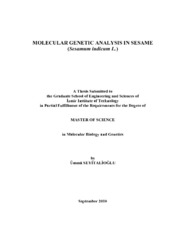Please use this identifier to cite or link to this item:
https://hdl.handle.net/11147/4013Full metadata record
| DC Field | Value | Language |
|---|---|---|
| dc.contributor.advisor | Doğanlar, Sami | en |
| dc.contributor.author | Seyitalioğlu, Ümmü | - |
| dc.date.accessioned | 2014-07-22T13:52:58Z | - |
| dc.date.available | 2014-07-22T13:52:58Z | - |
| dc.date.issued | 2010 | en |
| dc.identifier.uri | http://hdl.handle.net/11147/4013 | - |
| dc.description | Thesis (Master)--Izmir Institute of Technology, Molecular Biology and Genetics, Izmir, 2010 | en |
| dc.description | Includes bibliographical references (leaves: 49-53) | en |
| dc.description | Text in English; Abstract: Turkish and English | en |
| dc.description | x, 72 leaves | en |
| dc.description.abstract | In this study, 156 Turkish sesame (Sesamum indicum L.) accessions were characterized morphologically and 161 accessions were characterized genotypically. A total of 15 criteria were used for morphological characterization. Simple Sequence Repeats (SSRs, microsatellites) were used to characterize genetic variability among Turkish accessions. A total of 318 new EST based SSRs were developed for genotypic analysis. Also, these microsatellites were screened in Korean-Japan and African sesame accessions (parents) for future map construction studies. According to the morphological analysis, some characters showed variation whereas some characters had no variation among accessions. For example, height of first capsule, capsule number per plant, plant height, number of branches, number seeds/capsule, days to 1st flower and days to %50 flower characters showed variation among accessions. However, stem hair, leaf hairs, axil flower number, number of carpels/capsule and capsule hairs showed variation for only a few accessions. Also, growth habit, branching and capsule splitting characters had no variation. In accordance with genetic characterization, survey results showed only five polymorphic markers among 318 EST based SSR markers. Also, in this study, genetic distance of Turkish sesame accessions was calculated using DICE matrix and UPGMA (Unweighted Pair Group Method) arithmetical averages via 19 EST based SSR fragments. Genetic analysis showed that Turkish sesame accessions have fairly low genetic diversity. As a result, genetic diversity among Turkish sesame accessions were defined and the genetic relationships of Turkish sesame accessions were established. | en |
| dc.language.iso | en | en_US |
| dc.publisher | Izmir Institute of Technology | en |
| dc.rights | info:eu-repo/semantics/openAccess | en_US |
| dc.subject.lcsh | Plant molecular genetics | en |
| dc.subject.lcsh | Sesame--Molecular genetics | en |
| dc.title | Molecular genetic analysis in sesame (Sesamum indicum L.) | en_US |
| dc.type | Master Thesis | en_US |
| dc.institutionauthor | Seyitalioğlu, Ümmü | - |
| dc.department | Thesis (Master)--İzmir Institute of Technology, Molecular Biology and Genetics | en_US |
| dc.relation.publicationcategory | Tez | en_US |
| item.languageiso639-1 | en | - |
| item.openairecristype | http://purl.org/coar/resource_type/c_18cf | - |
| item.fulltext | With Fulltext | - |
| item.grantfulltext | open | - |
| item.cerifentitytype | Publications | - |
| item.openairetype | Master Thesis | - |
| Appears in Collections: | Master Degree / Yüksek Lisans Tezleri | |
Files in This Item:
| File | Description | Size | Format | |
|---|---|---|---|---|
| T000887.pdf | MasterThesis | 973.91 kB | Adobe PDF |  View/Open |
CORE Recommender
Page view(s)
110
checked on Sep 30, 2024
Download(s)
108
checked on Sep 30, 2024
Google ScholarTM
Check
Items in GCRIS Repository are protected by copyright, with all rights reserved, unless otherwise indicated.